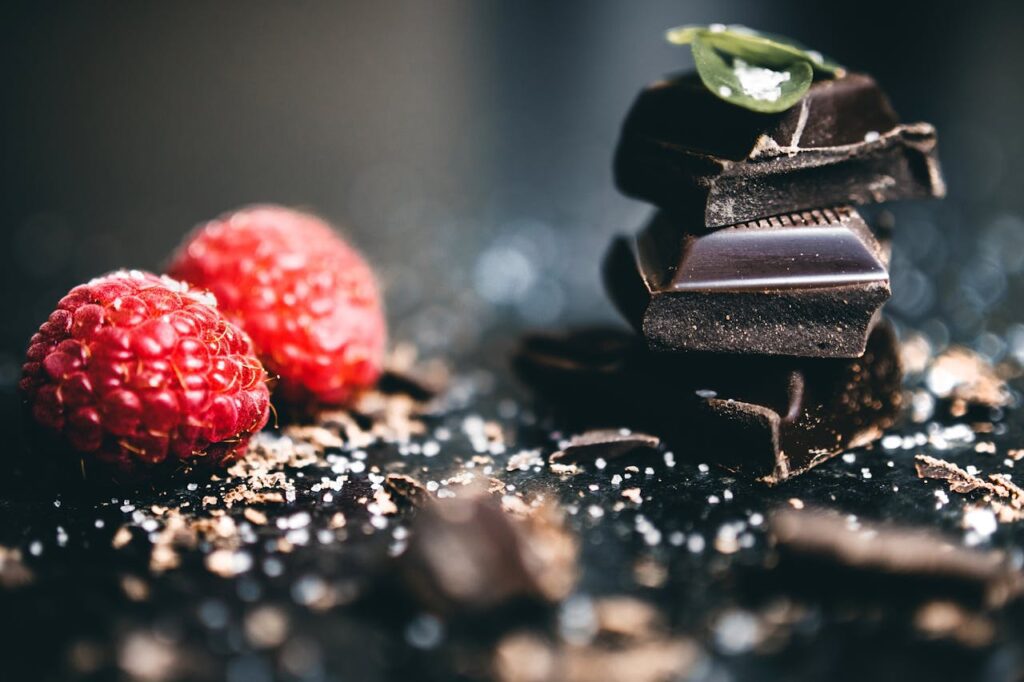26 Fun Facts About Chocolate
Chocolate: it’s more than just a treat; it’s a global love affair. From its ancient roots to its modern innovations, chocolate has a fascinating story to tell. Let’s dive into 26 fun facts about chocolate that demonstrate its rich history, surprising benefits, and cultural significance.

Ancient Currency: The cacao bean, the primary ingredient in chocolate, was so valuable to ancient Mayans and Aztecs that they used it as currency. Imagine buying goods with chocolate instead of coins!
A Gift for the Gods: The Aztecs believed chocolate was a divine gift from the god Quetzalcoatl, the god of wisdom. They prepared chocolate beverages for rituals and offerings, showcasing its sacred significance.
Christopher Columbus’ Discovery: Although not recognizing its potential, Columbus was the first European to encounter cacao beans in 1502, bringing them back from his voyages. Little did he know, he was introducing a future global obsession.
Europe’s Sweet Secret: Chocolate remained a secret among the Spanish nobility for almost a century after it was brought to Spain. It was enjoyed as a luxurious, sweetened drink, far removed from its bitter beginnings.
The Birth of Solid Chocolate: The evolution from drink to bar happened in 1847 when Fry’s of England mixed cocoa butter, cocoa powder, and sugar, creating the world’s first chocolate bar, revolutionizing how we consume chocolate.
Swiss Innovation: Switzerland is not just famous for its Alps but also for being the birthplace of milk chocolate in 1875. Swiss chocolatier Daniel Peter’s addition of milk powder to chocolate changed the game, creating a smoother, sweeter chocolate.
A Healthy Heart: Studies have shown that dark chocolate, rich in cocoa solids, can improve heart health by lowering blood pressure and improving blood flow. It’s a delicious prescription for a happy heart!
The Chocolate River: Roald Dahl’s “Charlie and the Chocolate Factory” was inspired by the author’s childhood experiences as a taste tester for a chocolate company. His imaginative world of chocolate rivers wasn’t just fantasy; it was rooted in his own dreams.
Belgium’s Chocolate Coins: Belgium, renowned for its quality chocolate, introduced the concept of chocolate coins, which have become a festive treat around the world, especially during holidays.
The Largest Chocolate Bar: In 2011, the British chocolate company Thorntons created the world’s largest chocolate bar, weighing a staggering 5,792.50 kilograms. That’s a lot of chocolate to love!
Cacao vs. Cocoa: While often used interchangeably, “cacao” refers to the raw beans and their products before processing, whereas “cocoa” typically refers to the processed powder. Each offers a different taste and nutritional profile.
Chocolate’s Mood-Boosting Powers: Chocolate is known to boost mood, thanks to its phenylethylamine content, often referred to as the “love drug.” It stimulates the brain’s pleasure centers, making us feel good.
A World of Flavors: Today, chocolate is not just limited to dark, milk, and white varieties. Artisan chocolatiers experiment with a myriad of flavors, from spicy chili to lavender, expanding chocolate’s culinary horizons.

Interesting Facts About Chocolate Continued:
The Fear of Running Out: The term “chocapocalypse” has been coined to describe the fear that the world might one day run out of chocolate, due to increasing demand and challenges in cacao cultivation.
White Chocolate Isn’t Technically Chocolate: Since white chocolate contains cocoa butter but no cocoa solids, it’s not considered “real” chocolate by purists. However, its creamy texture and sweet flavor have earned it a dedicated fan base.
Cacao Tree Longevity: A single cacao tree can live for up to 200 years. However, it only produces cacao beans suitable for chocolate making for about 25 years of its life, making sustainable cultivation practices crucial.
The Cocoa Belt: Cacao trees thrive in the narrow band known as the “Cocoa Belt,” which lies 20 degrees north and south of the equator, encompassing regions like West Africa, Southeast Asia, and South America.
Ghana and Ivory Coast’s Chocolate Dominance: Together, Ghana and Ivory Coast produce more than half of the world’s cocoa, making them central to the global chocolate industry.
The Complexity of Chocolate Tasting: Much like wine, chocolate tasting is an art. Connoisseurs evaluate chocolate based on criteria such as flavor, aroma, and texture, with high-quality bars offering a complex profile of tastes and scents.
The Nobel Connection: A surprising study found that countries with higher chocolate consumption have more Nobel laureates per capita. While not causal, it’s a fun correlation that highlights chocolate’s esteemed place in society.
Chocolate in Space: Another interesting fact about chocolate is that it has traveled to space as part of astronauts’ diets, offering a comforting taste of Earth amid the stars. Its durability and morale-boosting properties make it an ideal space treat.
The Mesoamerican Chocolate Tradition: Before it became a global phenomenon, chocolate was consumed in Mesoamerica in various forms, including as a frothy, spiced beverage and even mixed with grains to create a primitive form of chocolate bar.
The Health Benefits of Dark Chocolate: Beyond heart health, dark chocolate is loaded with antioxidants and has been linked to improved brain function, making it a sweet treat with some serious health perks.
Fair Trade Chocolate: The rise of fair trade chocolate addresses concerns about the ethical sourcing of cocoa, ensuring farmers receive fair compensation and promoting sustainable farming practices.
Chocolate Sculptures: Skilled chocolatiers have taken chocolate art to new heights, creating intricate sculptures and artworks entirely out of chocolate, showcasing the medium’s versatility beyond culinary uses.
The Mayan Chocolate God: The Mayans worshipped a god of cacao, Ek Chuah, celebrating him with an annual festival that included chocolate drinks, feasts, and sacrifices, highlighting chocolate’s deep-rooted cultural significance.
From its ancient ceremonial uses to its role in modern gastronomy and art, chocolate continues to enchant and innovate. Each bite carries with it a story of cultural heritage, craftsmanship, and the simple joy of indulgence.
Frequently Asked Questions About Chocolate
Chocolate, with its rich history and diverse range of flavors, naturally inspires a lot of curiosity. Here are some frequently asked questions about chocolate that explains its secrets and why it remains one of the world’s favorite treats.
What’s the difference between dark, milk, and white chocolate? Dark chocolate contains cocoa solids and cocoa butter, with little to no milk added, offering a rich, intense chocolate flavor. Milk chocolate includes milk powder or condensed milk, giving it a creamier, sweeter taste. White chocolate, made from cocoa butter without the cocoa solids, has a sweet, mild flavor and a creamy texture.
Can chocolate really be good for your health? Yes, in moderation. Dark chocolate, in particular, is rich in antioxidants like flavonoids, which can improve heart health by increasing blood flow and lowering blood pressure. However, chocolate is also high in calories and sugar, so it should be enjoyed as part of a balanced diet.
Why does chocolate melt in your mouth? Cocoa butter, one of the main ingredients in chocolate, has a melting point that is just below the human body temperature (about 93°F or 34°C). This property allows chocolate to melt smoothly in your mouth, creating that delightful sensation.
How should chocolate be stored? Chocolate is best stored in a cool, dry place at around 65-68°F (18-20°C) and at low humidity. Refrigeration can cause chocolate to “bloom,” where sugar or fat rises to the surface, creating a white coating. While bloom doesn’t affect the taste, it can alter the texture and appearance.
What is the “Cocoa Belt”? The Cocoa Belt refers to the equatorial zone where cacao trees grow best. This narrow band spans about 20 degrees north and south of the equator, covering regions in Africa, Central and South America, and Southeast Asia.
Why is Belgian chocolate famous? Belgian chocolate is renowned for its quality and craftsmanship. Belgium’s chocolate-making tradition dates back to the 19th century, and it’s known for its strict regulations regarding the use of pure cocoa butter and the artisanal methods employed by chocolatiers.
What is single-origin chocolate? An interesting fact about single-origin chocolate is that it is made using cacao beans from one specific region or even a single plantation. This type of chocolate highlights the unique flavors and characteristics influenced by the local climate, soil, and cacao variety, offering a distinct tasting experience.
Is chocolate vegan? Dark chocolate can be vegan if it doesn’t contain any animal products like milk. However, it’s important to check the label, as some dark chocolates might include milk derivatives or other non-vegan ingredients. Milk and white chocolates are not vegan due to their dairy content.
How is chocolate made? Chocolate production involves fermenting, drying, and roasting cacao beans, then grinding them into a liquid paste called chocolate liquor. This liquor can be further processed into cocoa solids and cocoa butter, which are then combined with ingredients like sugar and milk to make various types of chocolate.
Can chocolate cause allergies? Chocolate itself is rarely the cause of allergies, but ingredients commonly added to chocolate, such as milk, nuts, and soy lecithin, can trigger allergic reactions in some people.
What’s the best way to taste chocolate? Tasting chocolate is an art similar to wine tasting. Start by looking at the chocolate’s appearance, then smell it to anticipate its flavors. Break a piece to listen for a sharp snap, indicating quality. Let it melt slowly in your mouth, noting the flavors, textures, and aftertastes.
Why is some chocolate fair trade? Fair trade chocolate ensures that cacao farmers receive a fair price for their beans, promoting sustainable farming practices and better working conditions. It addresses issues like poverty and child labor in the chocolate industry.
Exploring the world of chocolate reveals a delicious blend of culture, science, and artistry. Each bite carries the legacy of ancient traditions and the complexities of modern production.













